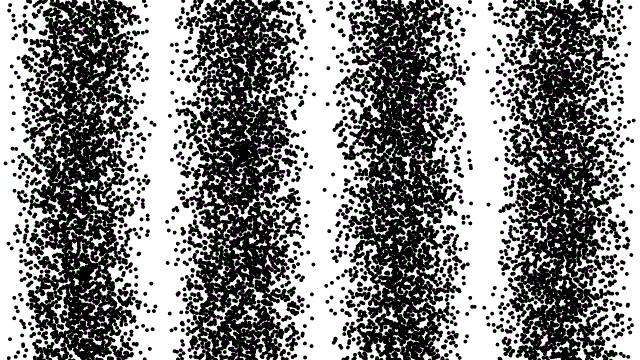5.4: Double-Slit Experiment
( \newcommand{\kernel}{\mathrm{null}\,}\)
Wave-Particle Duality
Okay, so we have established that light can behave as a particle (photon) or as a wave (Maxwell). It seems as though how it behaves simply depends upon the context we put it into. If we do the experiments of 9B (polaroids, double slit interference, etc.) then it is clearly a wave, but if we do the experiments of the 20th century (blackbody radiation curve, photoelectric effect, Compton scattering), then it acts very much like a particle. But how can a single entity simultaneously act like two such opposite phenomena? Is light localized into little packets of energy, or is it spread out and able to exhibit interference? IT CAN’T BE BOTH!! This mystery is what physicists refer to as wave-particle duality. Giving it a name helps us manage our sanity, as it fools us into thinking it is reasonable. Okay, so we have actually done more than just give it a name, but the reader should understand at the outset that ultimately this is just another one of the incomprehensible wonders that comes from modern physics.
Very Low Intensity Double Slit Interference
Perhaps nothing demonstrates the wave nature of light better than the phenomenon of double slit interference. Let’s start with a quick refresher…
Light (a wave) arrives in phase at two slits, and part of the wave originated from each slit. The light (a wave) from each slit source spreads out to all parts of the screen and at each point on the screen the two waves arrive at some relative phase. If the phases are different by an even integer times π (because of the path length difference), then the light (a wave) interferes constructively, doubling the amplitude and quadrupling the intensity. If the phases are different by an odd integer times π, then the light (a wave) interferes destructively, resulting in zero intensity.
This seems like a phenomenon that can't possibly accommodate photons as particles. But our study of the photoelectric effect gives us a way to test this possibility. In the photoelectric effect, we said that the overall energy that hits a metal plate has two factors that play a role: The energy of each photon, which is proportional to that photon's frequency (the color of the light), and the total number of photons landing on the plate per second (the intensity, or brightness of the light). Suppose we greatly reduce the intensity of the light, to the point where only one photon is fired through a double-slit apparatus per hour. Only a wave can pass through both slits at once and interfere with itself on the other side. A particle has to pick one slit or the other to go through. So by reducing the intensity to one photon per hour, we should not see a light interference pattern. But if the light is actually a wave, we should see n interference pattern, albeit an extremely dim one.
So what happens when we do this? Well, in fact we do see the one-photon-per-hour scheme demonstrate that photons are particles. Every time a photon is fired through the double-slit, a single dot appears on the screen behind the slit, not a continuous distribution of light brightness displaying the interference pattern! So that settles it, light is a particle, and apparently when many particles are fired together, they affect each other's paths (maybe by bumping into each other) in a manner that they replicate a wave interference pattern, tricking us into thinking that light is a wave.
Well this interpretation certainly seems reasonable until someone accidentally leaves the machine on during the month-long winter break. When they come back, they see the dots on the screen where the hundreds of photons landed after passing through the double slit. They don't land in the same place every time, but they don't land perfectly randomly, either – they form a pattern... a familiar pattern. Below is a simulation of what is seen, sped up many times the actual one-dot-per-hour rate.
Figure 5.4.1 – One-Photon-at-a-Time Through a Double Slit

Our perfectly reasonable idea that light as particles can exhibit wavelike interference behavior by having particles interact with each other fails miserably! The photons travel alone, free from being affected by any other photons, and yet when all the photon landings are aggregated, the interference pattern emerges! We are foiled once again from definitively showing that light is either a particle or a wave.
The only explanation left to us requires a statistical argument: The pattern shown on the screen must represent a probability distribution for the landing points of the individual photons. The places dense with dots are places where a single photon has a very high probability of landing, while those less dense are less probable landing points (and those with no dots have zero probability of a photon landing there!).
The strange part of all this is that these probabilities appear to obey wave mechanics. That is, when we change the spacing between the slits, and the wavelength of the photons, the pattern changes in a manner that is precisely consistent with wave interference. This puzzle of something as abstractly mathematical as probabilities being subject to the rules that exist for waves is one of the most fundamental aspects of what is known as quantum theory. Indeed the use of the very word "quantum" goes to the heart of this. As we will see, wave-particle duality is not the only place where something we expect to be smooth and continuous (like a light wave's interference pattern) turns out to be discrete (like a single dot on a screen). This probabilistic/statistical interplay between what we see in the big picture as continuous, and what we see in the small scale as discrete leads us to invent new language to describe quantities that doesn't imbue them with inherently "particle" or "wave" properties. We then generically refer to these quantities as "quanta".


